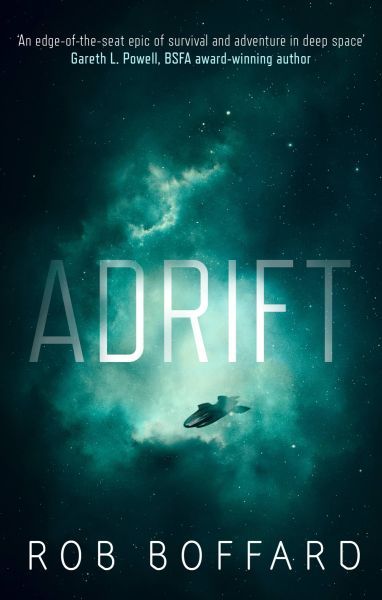Far Beyond a Star
Adrift
By Rob Boffard

4 Jun, 2018
Rob Boffard’s 2018 Adrift is a standalone SF adventure.
Sigma Station began as a helium three mining station. Its spectacular view of the Horse Head Nebula transformed it into a tourist destination. Now it has been slated to play a crucial role in interstellar relations.
Not a role that most of the station’s inhabitants will survive to appreciate, mind you.
[spoiler warning]
The war between the Earth-centric Frontier Government and the breakaway Colonies ended years ago. While the station near Sigma Orionis, one of the first systems reached by the wormhole network, saw its share of action during the war, the war is long over. The mining facility has been eclipsed by newer, more productive helium three mines. The savage attack that reduces the station to scrap comes as a surprise. Well, it would have been a surprise if the people in the station had not died before they could feel anything,
Only the tour boat Red Panda, its eight passengers, and two crewmembers survive the initial attack. Hidden amongst the debris, the craft can hide from the enemy — for now. Without armour or weapons, it is unlikely the craft could survive a dash for the local stargate or passage through it. Not that the last point matters, since their attackers soon destroy the gate, the only means of exiting the system.
Never intended for long-range travel, the Red Panda has limited life support. Even if the enemy somehow overlooks them, waiting is a death sentence. Survival depends on the ability of the ten survivors to outsmart a heavily armed ship full of trained soldiers.
The good news is that the random collection of people on the Red Panda turns out to contain folk with applicable skills. The bad news is that they also have serious issues with coordination and impulse control….
~oOo~
I really wanted to like this. Oh, well.
A curious thing about SF is that many SF economies are resource-extraction obsessed. Even in Canada, which is stupidly dependent on primary industries (and oblivious of the Dutch Disease and the vagaries of markets), primary industries only employ 4% of the population and generate 6% of the GDP. Most workers are in the service industries. If a nation of plaid-flannel-shirt-wearing, unique-place-name eschewing1 poutine swillers can manage complex economies, why does SF give the impression of being perpetually stuck in a particularly backward part of the 19th century?
The specific resource humans covet in this novel is helium three, because of course it is. On the plus side, at least it isn’t lunar helium three; non-lunar sources are at least potentially less problematic than the Moon, provided they are either Mars-sized and very cold, or gas/ice giants. On the minus side, helium three isn’t that attractive as a fusion fuel. Helium three + deuterium is harder to ignite than deuterium + tritium and not as aneutronic as its fans like to claim.
The sheer quantities of the stuff these people are said use are astounding. Sigma produces twenty million tonnes of helium three a year. If Atomic Rockets can be believed, each kilogram of helium three + deuterium is good for about 350 TJ. Twenty million tonnes per year should provide about 7×1024 Joules per year or 2×1017 Watts (assuming no basic math errors on my part and I am pretty thumb-fingered on my phone’s HP 11C emulator.) For comparison, all humanity currently uses about 2×1013 W. Even more impressive, Sigma is a minor source of helium three. This is a civilization that uses a lot of energy, not necessarily an unreasonable assumption when one considers that high-thrust, high-delta-vee rockets are necessarily power hogs2.
Still, helium three is a minor part of the setting. The plot is one part Life Boat to one part Run Silent, Run Deep. Stealth is notoriously problematic in space, although in this specific instance the Red Panda is surrounded by the debris of the station.
Granted, it is hard not to read passages like
The Red Panda is maybe half a mile below her, side-on, its viewing dome pointed in the direction of her three o’clock. And coming up beneath it, like a shark in murky water, is the giant bulk of the Colony ship.
as suggesting that deep space is fog-filled.
What really seems to be going on is that the attackers are incompetent. They appear to be the sort of maladroit villains who can be TPKed by an enthusiastic, motivated amateur. Because the plot can’t work if they are good at their job.
I should also add the bad guy’s grand plan, which depends on nobody asking how it was that Colony forces (which the attackers are pretending to be) reached a facility whose only link to other systems is through a Frontier-controlled wormhole, is utterly implausible. How did the Big Bad expect to get away with such a dumb ploy?
Not only are the villains incompetent, the survivors on Red Panda are surprisingly lethal. Unfortunately, most of this lethal violence is directed at their own teammates. Not everybody in Red Panda survives to see the final credits; none of the casualties on the tour boat are due to enemy action.
If I try to overlook the issues with the worldbuilding, I run into the implausibility of the plot. Nor was I particularly taken with any of the characters. This book was not for me.
Adrift is available here (Amazon) and here (Chapters-Indigo).
1: Ontario had four communities claiming the name Niagara Falls until the post office stepped in. Heck, the Fathers of Confederation had two men named John Hamilton Gray. The fact that the two factions in Adrift use bland names like Frontier and Colony suggests some foolish person allowed Canadians to name things.
2: I am aware that energy and power are two different (although related) things. If you care to expand on this subject in comments, please do.
